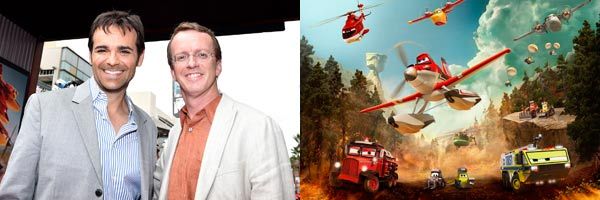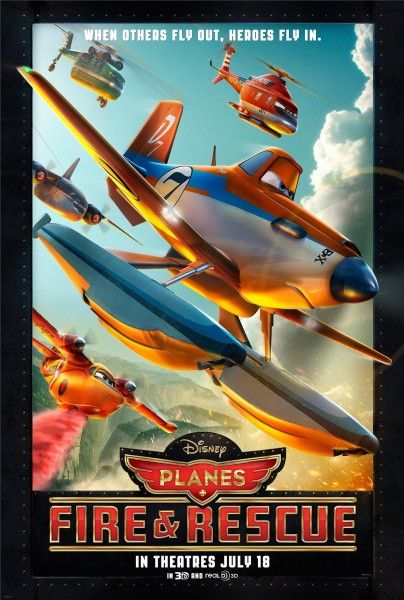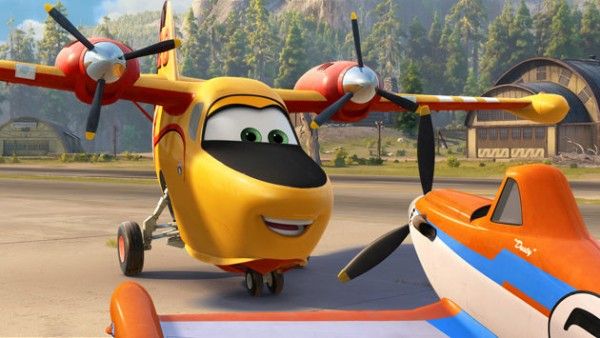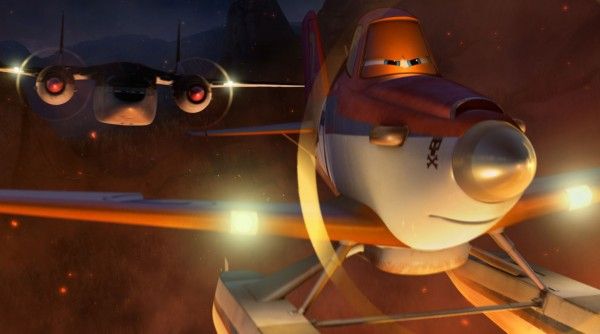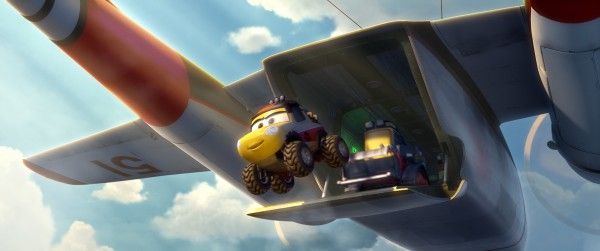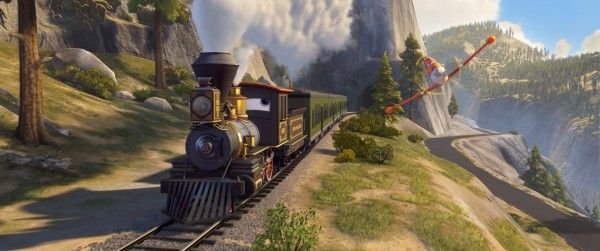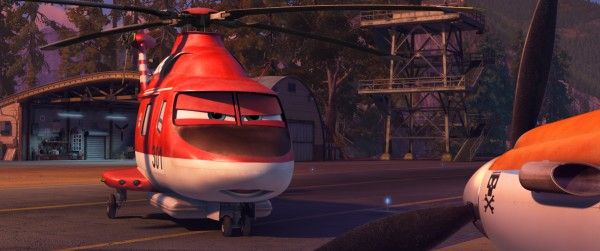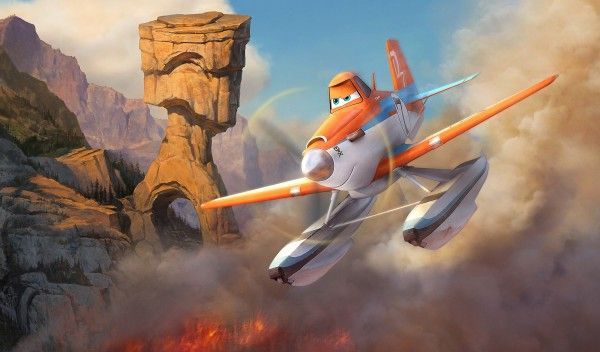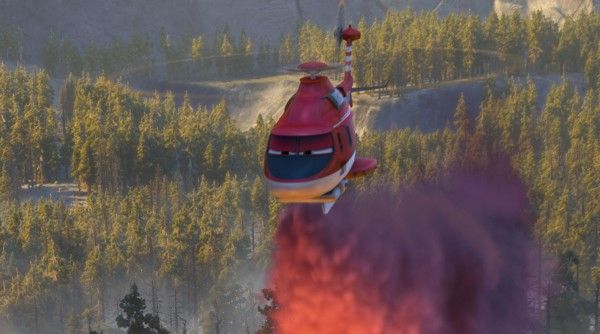When world-famous air racer Dusty Crophopper (Dane Cook) is sidelined by a career-ending injury, he finds himself searching for his next chapter in life in Disney’s Planes: Fire & Rescue. Directed by Bobs Gannaway from a screenplay by Jeffrey Howard and produced by Ferrell Barron, the animated adventure-comedy centers on a crew of elite firefighting aircraft whose mission is to protect historic Piston Peak National Park. The family friendly film about second chances features thrilling firefighting action scenes and an impressive voice cast that includes Curtis Armstrong, Julie Bowen, Ed Harris, John Michael Higgins, Hal Holbrook, Regina King, and Wes Studi.
At the film’s recent press day, Gannaway and Barron talked about how they wanted to elevate the storytelling from the first film and tell a deeper story with the main character, the extensive research they did to ensure the authenticity of the story and to portray aerial firefighting accurately, why they consider this the most ambitious film they’ve done at Disneytoons Studios, the decision to go Cinemascope, how their visual effects team created believable large-scale fires and visually striking firefighting scenes, their personal connections to planes, and future plans to explore more in the world of anthropomorphized vehicles. Check out the interview after the jump.
Question: Are you guys experts on the world of fire and rescue now?
BOBS GANNAWAY: Yes. Actually people sometimes ask, “Did you have an association with it beforehand?” and we didn’t. The plane itself, Dusty Crophopper, is a crop duster plane that’s used in wildfire air attack. It’s known as a SEAT, a single engine air tanker. That information is actually in the movie. That led us into wildfire attack, so we went out to meet the firefighters and ended up going to air attack bases here, going to their training exercises, and going to other bases like up in Grass Valley.
Ultimately, they basically became our friends, and there was a Battalion Chief by the name of Travis Alexander who became the main consultant for the firefighting on the film to make sure the chatter is correct, that the retardant drops look accurate, and that all those things are true to the world. There’s lots of cheats in the film because we compressed the process and things like that, but I think people like to go to movies for different reasons. One of the things I like to think they go to movies for is to see a process they don’t know anything about. And so, it was important to us to represent that process accurately. You don’t know that that’s the way it’s done, but again, it also makes the world feel real even though it’s an animated film by grounding the characters in a real world. Then hopefully, you get involved in the story and what’s going on with the characters, and all the details become things that you feel and don’t see.
Individually, what were your goals for the project?
FERRELL BARRON: As the producer, you want to support the director’s vision and help bring that vision to the screen. So, knowing the scale of this movie, being a fire movie, and we’re going to have fire effects, we knew right out the gate this was going to be the most ambitious movie we’ve done at Disneytoon Studios. Over half our movie has fire, smoke, water, or a combination of those elements, which is very labor intensive and just flat out hard. My goal was to be sure we were set up for success. We had to start off early with the fire effects. It took us over 2-1/2 years to get that fire effect, to build it, to get it to where it looked real, because everything we do we want to be sure is built off the truth and looks as accurate as possible, but then also that it can be producible. The movie took four years to make, and a lot of times, this kind of stuff is such a heavy footprint in the CG world that you can lock up, so we had to come up with this library system where we made over 50 different fire elements that could basically be set dressed in all of those shots. All of this was used for mid-ground and background fire, and that really reduced our footprint and made it a lot easier.
And then, we saved all the custom shots which would be very specific animated fire shots that had to act a certain way and was integrated with the character. That’s more difficult. We saved those for very specific callabouts that were very important to Bobs in the story. So, my biggest challenge was to be sure we set ourselves up for success, that we were anticipating the roadblocks that always come up in production, and that we had those levers we could pull and ways that we could work around them.
GANNAWAY: For me, it was to elevate the storytelling from the first film. I started out as a writer, and so I really wanted to make sure we told a deeper story with the main character, and that’s why we ended up with this idea of second chances. I needed Dusty to actually struggle with a real problem that is tragic, and so, the idea of second chances and the idea of you can no longer pursue your passion and can you find another passion worth living for. It’s like if you’ve lost your love, can you love again? It’s a scary question. People would say, “That feels like a very mature theme” and I was like, “Good.” But it can also apply to an older audience if you’ve lost a loved one. Can you love again? Or to a kid who doesn’t make the soccer team. And then, that theme ended up threading through other things. When we went to the Air Attack bases, most of the aircraft, almost all of the aircraft they use are on second lives. It’s former military aircraft. It’s former civilian aircraft. Fire itself is about burning and then clearing away the old and allowing for rebirth. So, for me, it was about elevating the storytelling.
The second thing was to give the audience something they hadn’t gotten before in this world. The previous film was a race film, so it was important to change the genre and to do in this case sort of a disaster-action-comedy film. Hopefully, I’ve worked very hard to not be derivative of the previous films, such as the romance with Dipper and Dusty and making sure she’s awesome, but even making sure that Blade (Ed Harris’ character) is a fully realized mentor. He’s not a broken mentor like Skipper was or even Doc from Cars. That’s a character that we’d done wonderfully in these two previous films. Blade has already come to terms with the tragedy in his life and moved on, and that’s what he can share with Dusty, which is a little different than what we’d done before. I tried to make choices so that there’s something new and something deeper in the movie.
Can you talk a little about each of your personal connections to planes? Did you grow up wanting to be a pilot, or loved planes, or liked to travel in planes?
BARRON: Well, for me, like any kid, I always loved the idea of flying in planes. But before, I was at Disneytoons prior and left. When I left, I was actually working more on the live-action documentary side, and I was doing documentary work with WWII aircraft, like P-51 Mustangs, Corsairs, and Sabres. Being in that world, all those aircraft have such great and interesting stories and histories that really fascinated me. There are always such great stories there. But, I was missing animation. And then, when I heard about the Planes franchise back at Disneytoon Studios and the rebirth of it with John Lasseter taking control of it, it interested me to get back to animation again and hopefully bring some of those great aviation stories back to Disney as well and help support this new series that they were developing.
GANNAWAY: I didn’t really have a connection. (Laughs) They were something in the sky above me and I was a little nervous. Actually, it allowed me to walk into it sort of wide-eyed in the sense of discovering this world and having it open up to me as I got involved. One of the great perfect examples is, obviously in the movie we have fixed-wing aircraft, but we feature a couple of helicopters in our movie very much. Ed Harris plays Blade and Wes Studi plays Windlifter, so it was important to get the helicopter flight accurate. I was having dinner with a friend of mine several years ago, and I mentioned that I was working on a movie that was going to have helicopters, and he said, “I know someone who’s a friend of my wife’s who’s a helicopter stunt pilot,” and I said, “Oh, I’d love to talk to him.” Well, it turned out to be Chuck Aaron. Now if you don’t know who Chuck Aaron is, you just Google Chuck Aaron. He’s the top stunt helicopter pilot in the world. He’s only one of two people in the world to do an inside loop in a helicopter and things like that. He’s the nicest guy in the world as well. He refers to himself as a methodical risk taker. It all works on paper. He’s based out here in Camarillo, so we went out to go meet him, and he said, “Do you want to go up for a flight?” and we were like, “Of course!” So he took us out in the helicopter and did barrel rolls and inside loops. All you have to do is watch a YouTube of him and your jaw drops. So again, no, I didn’t have any experience beforehand, but I got to have this wonderful experience of going out there and having the world open up to me.
With the first Planes, you guys did not know that it was going to be released in theaters until the very last minute, but with the sequel, you did. Did that encourage you to bring that storytelling to the next level in terms of the production value?
GANNAWAY: Well, we knew Klay (Planes director Klay Hall) was going to go theatrical. We knew obviously early on, and we were just starting, so we always intended to go theatrical. The first thing I did was put it in Cinemascope because I wanted to celebrate the vehicles. These planes have big wingspans, so I wanted to get the whole plane in the scene. Also, I wanted to get that sort of panoramic quality of the National Parks which are amazing. So, obviously going Cinemascope was the big choice, but then also elevating the effects. It was a tough movie. When we had just pitched it and we had one piece of conceptual art, we showed it to John (Lasseter), and he was like, “You need to start working on that fire now. We’ve never done fire to this level.” The fire is a character. It thematically works into the movie. It’s like the monster of the film. Getting that fire to be accurate was tough.
BARRON: In the National Parks, as Bobs says, that was the big thing. It has such broad vistas. It’s such a big world. The world itself is so large as well. I mean, it deserved to be wide screen, so we knew everything about it, from the storytelling to the visuals to the effects. Everything about this movie was going to be bigger than the first and previous attempts, so we wanted to be sure we were giving it its due justice.
GANNAWAY: At the end of the day, it’s about elevating the storytelling. We’ve all seen wonderful films with great effects, but then we just don’t care. And so, you have to care. That’s why we tapped into this theme of second chances. That hopefully will make the movie great because you have something to care about in addition to all the great effects and everything.
Can you give us a general idea of how many people it took to make this movie, because I know there were probably hundreds working on the fire alone?
BARRON: Nine hundred total. A hundred of those were just consultants, so not even production personnel. These were just consultants – firefighters, park rangers, aircraft mechanics, oil analysis experts, and all these people who were a huge part of making the movie, because we’re making it truthful and accurate so they have to be a part of it. So, we had 100 of those and 800 of just production crew over four years. It was a big undertaking.
The National Park is such a big part of the story as well. Have you got a connection to that?
BARRON: I think it’s the same. It’s just the love of visiting parks like anybody. Our National Parks system is such a piece of Americana, too, from camping and spending time with your family. Some of the consultants were also a part of the National Park System. Dr. Jonathan Jarvis, the Director of the National Park Service, came in from Washington, D.C. He saw the movie and wanted to see how we were representing the parks.
GANNAWAY: Jonathan Jarvis had been the superintendent of many parks. So, before he saw the movie, I made sure to let him know that we had a superintendent in our film that is making some wrong choices. He has the best of intentions. He wants to protect this historic lodge that would never be rebuilt if it were burned down, but maybe not at the expense of lives. I made sure I teed up Cad Spinner a little bit for him. He was just a little nervous, but actually at the end of the day he loved it. He loved the details. He loved the fact that most National Parks have rocking chairs in front of the fireplaces. It’s a little tradition of the National Parks. You’ll see in the movie that we have rocking chairs in front of the fireplaces. Robert Reamer, who designed the Old Faithful Inn at Yellowstone, also designed a train station at the north end of Yellowstone. It has since been destroyed, but we recreated that train station and hooked it to the fuselage. The train connects the fuselage to the train station. Nobody will know that, but it’s fun when you find there’s a little connection as to why you’re making your choices. Those are the fun things to discover along the way, and he appreciated that.
BARRON: We live in such a digital world, too. I think it was important to also have a movie about the National Park System because that has gotten lost a little bit from when I was a kid. So, helping them put that in the forefront again for kids nowadays to see National Parks and how beautiful they are and what a treasure they actually are to explore, I think it’s an important message.
GANNAWAY: That’s a great thing. I don’t think we were thinking about that so much when we started, but it’s such a lovely, residual thing to have gotten out of it and to celebrate the National Parks.
What are each of you working on next?
BARRON: (Laughs) Nothing yet really. Vacation plans. Sleep.
GANNAWAY: The answer to that question basically is what’s lovely about Disneytoon Studios, as well as Pixar and all Disney Animation Studios. It’s all under the John Lasseter umbrella and we have a group of directors and we all work together. So, each individual studio has a story trust groups of directors that work together. Disneytoon Studios makes series-based films. We’ll make a series of films based in a world. In this case, it’s the world of anthropomorphized vehicles. We’re going to continue to explore other ideas in that world, but we don’t have a mandate for a schedule or a time or a deadline. We wait until we find the right story, and then once we’ve found the right story and we’ve done our research, that’s when we’ll grow the movie out of that. So, that’s where we’re at right now. But right now, personally, I’m just finishing up this film, making sure it’s shared with all you lovely people and the people who will hopefully come out to see the movie, and then I will take a break and move on.
BARRON: That’s equally as exciting.
GANNAWAY: Yes!

